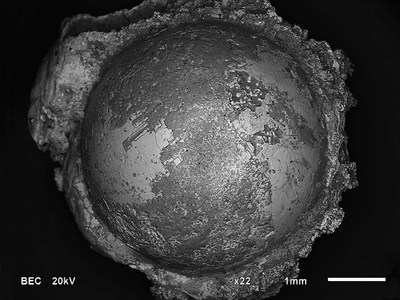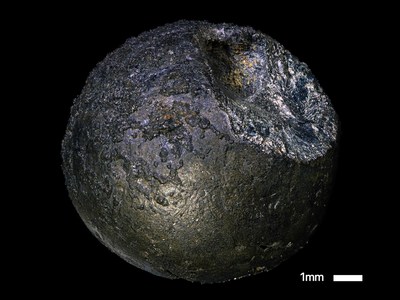NEW YORK, Aug. 24, 2021 /PRNewswire/ — A new study published in Meteoritics and Planetary Science presented conclusive evidence that iron silicide spherules, recovered in the Ural Mountains and New Jersey, belong to the previously unknown family of ultrahigh-temperature impact products formed in Earth’s orbit. Multiple similar finds of silicide spherules worldwide indicate that large-scale impacts capable of delivering ejecta to space have been more frequent in geological history than suggested by known evidence of cratering.
The origin of iron silicide, a mineral exceedingly rare for the Solar system and abundant for carbon stars, has puzzled scientists since its first discovery in 1859 in North Carolina. These shiny metallic spherules, found contrary to geological conditions in sedimentary rocks of various ages on four continents, seemed out of place on this planet. In the words of their original discoverer, C.U. Shepard: "All who have studied these objects attentively have recognized in them traits, wholly inexplicable from our knowledge of merely terrestrial matter." Now, a broad scope of previously unavailable isotopic, major, minor, and trace element compositional data has revealed that iron silicide spherules formed from a vaporized mixture of crustal and asteroidal materials ejected to space in hypervelocity meteoritic impact. The reported data shows that silicide spherules have condensed from vapor plume ejected beyond the atmosphere and have ablated on atmospheric reentry at a cosmic velocity exceeding 13 km/s.
The evidence of hypervelocity arrival from space is explicit. Melt-flow textures of the surface forming radiating ridges, ring-waves, and equatorial flanges, which make silicide spherules look like buttons, can unambiguously be ascribed to atmospheric entry only. Arc-jet ablation experiments have previously demonstrated that similar surface features, observed on australite tektites and meteorite models, reflect aerodynamic ablation rates corresponding to flight velocities well into orbital range. These features are universally accepted as conclusive evidence for hypervelocity atmospheric entry from space.
How is it known that iron silicide spherules are impact products? While the isotopic ratio of uranium and lead in the examined silicide spherules matches the meteoritic standard, the origin of these exotic particles is evident from the complexity of composition. Departures from terrestrial norms in isotopic compositions of rubidium, strontium, argon, and helium are one side of the coin. On the flip side, the isotopic ratios of samarium and neodymium point to upper crust sediments as precursor material. "This dichotomy in isotopes is a clear testament for impact provenance," says the co-author of the paper, Dr. Gulbin of the Mining Institute of St. Petersburg. Meanwhile, the internal structure of the spherules is consistent with accretion through the coalescence of tiny 3-5 micrometer droplets. The chemical composition of iron silicide spherules is closely corresponding to the 1893K – 1154K temperature span of condensation sequences predicted for carbon-rich gas. This can hardly be explained by any other formation process besides recondensation of impact ejecta vapor.
"Vapor plume ejection to space has been a neglected aspect in science of impact studies for too long. Iron silicide spherules offer the first-hand perspective into neglected phenomena," says the lead author of the study, Sergei Batovrin, who found silicide spherules with aerodynamic ablation features in the Ural Mountains. Similar silicide spherules, ranging between micrometer to a centimeter in size, were reported occurring in hard rock sediments of various ages in more than fifty locations worldwide. As long as the ejection of vapor plume to space requires release of kinetic energy in hypervelocity cosmic impact of grand-scale, the implications are startling. Iron silicide spherules indicate that cosmic impacts of catastrophic magnitude are far more frequent in geological history than suggested by evidence of cratering discovered so far.
REFERENCE:
Constraints on the origins of iron silicide spherules in ultrahigh-temperature distal impact ejecta.
Sergei Batovrin, Boris Lipovsky, Yury Gulbin, Yury Pushkarev, Yury A. Shukolyukov. 2021.
Meteoritics & Planetary Science, vol. 56, issue 7, pp.1369-1405.
Open access article https://doi.org/10.1111/maps.13662
PRESS CONTACT:
Sergei Batovrin
cell: 646-784-7762
317263@email4pr.com
SOURCE Sergei Batovrin



